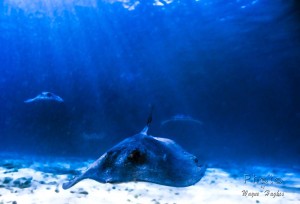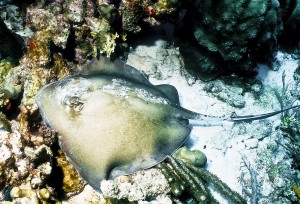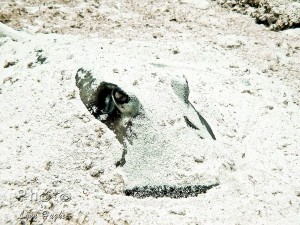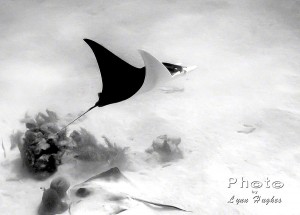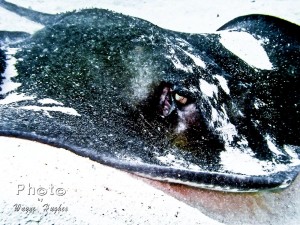Some of the most graceful creatures in the sea are undoubtedly the stingrays. Because of their shallow depth ranges and feeding patterns, snorkelers are also often able to see these unique creatures.
There are eleven species of stingrays in North America. Although they do not have a normal fish shape, stingrays are fish with a skeleton of cartilage just like sharks. Since stingrays are bottom feeders, their body has developed into a unique flattened, diamond shape formed by enlarged pectoral fins. These fins form pointed wing tips on each side of the body and extend forward past the mouth into a pointed snout. The absence of a dorsal fin, and a long whip-like tail, which is about the length of the body, further enhance their unique look. The pectoral fins are used for swimming, feeding, and when burying their bodies in the sand.
Stingrays are armed with one or two poisonous spines on their long tails. In the accompanying photo, this spine can be seen protruding slightly from the top edge of the tail just behind the body. Body color depends on the ray’s surroundings and varies from shades of light brown, gray, or olive green on the upper body with the bottom surface white with gray or brown edges. The ridge near the eyes and the tail are usually much darker.
Like many other masters at camouflage on the reef, Southern Stingrays can bury themselves in the sand in only a few seconds with a wave of their pectoral fins, leaving only the eyes and tail exposed.
Since these rays are bottom dwellers, versus swimming rays like the Spotted Eagle Ray and Giant Manta, their mouth and gill openings are located on the bottom side of the body. Moving backward and forward using their pectoral fins to stir the bottom sand, they dislodge worms, mussels, and small crustaceans which they suck into their mouth much like a vacuum. In turn, Southern Stingrays become a food source for larger fish like the Goliath Grouper and sharks, particularly hammerheads.
The Southern Stingray can reach body lengths of up to five and one half feet, excluding the tail, but the average is three to four feet long. Females are much larger than the males
Southern Stingrays can be found in all habitats and depths from one foot to around 80 feet deep, but they are more commonly found in sandy areas, near shores, or in bays where they feed. They have a wide range extending from the east coast of the United States down through the Gulf of Mexico and the Caribbean to Brazil.
By
Lynn Hughes

